Note: for the full suite of measurements from the SoundStage! Audio-Electronics Lab, click here.
 In an interview on Musical Fidelity’s website, company founder Antony Michaelson recalls, “When I started the company [in 1982], I was told by a lot of people that there was no room in the market for another amplifier brand. I did not listen to them and would tell my younger self, received wisdom is often wrong.” His tenacity paid off. Musical Fidelity grew and prospered for three decades.
In an interview on Musical Fidelity’s website, company founder Antony Michaelson recalls, “When I started the company [in 1982], I was told by a lot of people that there was no room in the market for another amplifier brand. I did not listen to them and would tell my younger self, received wisdom is often wrong.” His tenacity paid off. Musical Fidelity grew and prospered for three decades.
In 2018 Michaelson sold Musical Fidelity to Audio Tuning Vertriebs GmbH, parent company of Pro-Ject Audio Systems, and returned to his first love, making music. Michaelson is a fine clarinetist; I happen to own two unnumbered CDs from the Musical Fidelity label, each featuring his delectable performance of a clarinet quintet: Mozart’s on the one, Brahms’s on the other. In both works, Michaelson is accompanied by four top-notch musicians: Adrian Levine, Colin Callow, Jeremy Williams, and Robert Bailey. The Mozart was recorded in 1994 by none other than Tony Faulkner; the Brahms, in 1996 by Anthony Howell. Perfect recordings for testing Musical Fidelity’s new, top-of-the-line M6x DAC.
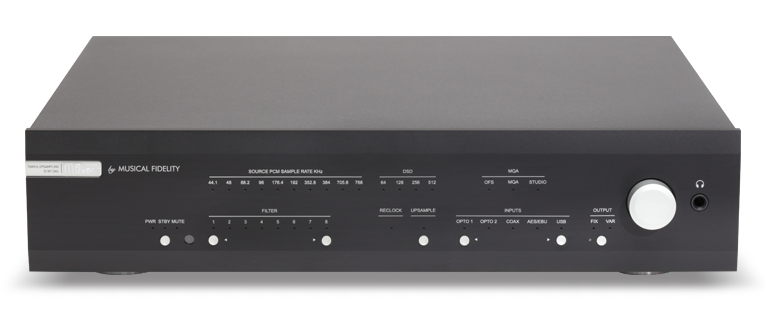
Description
Priced at $2500 (all prices in USD), the M6x DAC replaces the M6sR, which itself replaced the M6s, one of the first DACs to use ESS Technology’s Sabre ESS 32-bit HyperStream II architecture. The latest incarnation in the M6 series, the M6x DAC features a pair of ES9038Q2M chips in dual-differential mode, for a dual-mono design. Key to extracting the best sound from Sabre chips is the implementation of the power supply. The M6x DAC employs the latest version of Musical Fidelity’s Super Silent power transformer, an encapsulated toroidal transformer with low core saturation, fed from an industrial-grade power socket with an EMI filter and a DC blocker.
The M6x is not a streaming DAC, but it accepts a range of digital inputs: two optical and one coaxial S/PDIF, USB, and AES/EBU. Input selection is implemented with two buttons (previous and next) on the unit and on the supplied remote control. The USB input supports resolutions up to 32-bit/768kHz PCM, DSD256 DoP, and native DSD512, while the other four support PCM up to 24/192. Full support is provided for MQA. The balanced output delivers 4V RMS, the unbalanced 2V RMS. Nothing unusual so far, but the specifications for channel separation (>130dB at 10kHz), signal-to-noise ratio (>120dB at 1kHz), harmonic distortion (<0.0005% at 1kHz), linearity (<0.4dB down to –130dB), and jitter (<12psec peak-to-peak) are all exceptional. The M6x DAC’s headphone amp is specified to output 1.5Wpc into 32 ohms, with a claimed signal-to-noise ratio of >115dB. A conventional ¼″ jack is at hand on the front panel.
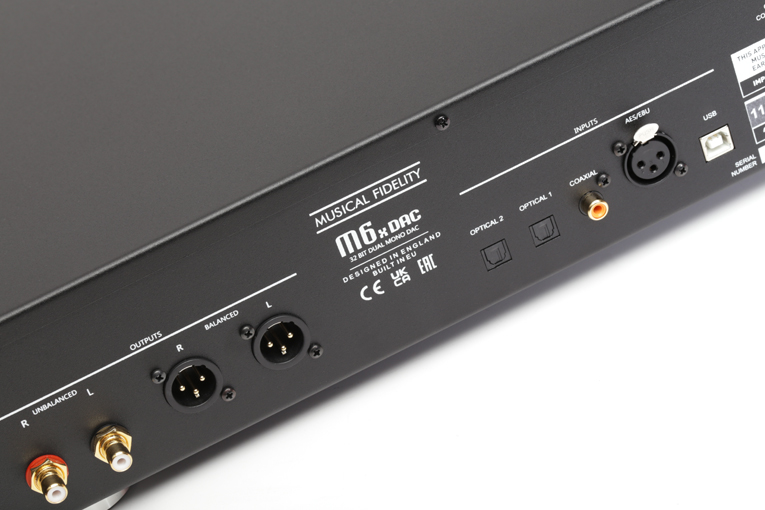
The M6x DAC’s line outputs can be set to fixed or variable level. Musical Fidelity does not make a big fuss about using the variable output to directly drive a power amp and neither should you—it works. But it’s not easy to adjust the volume in small increments from the remote control, and you can’t see what volume level you have set. The signal quality of the variable output, balanced or unbalanced, is well below that of the fixed output in resolution and dynamic range. Routing the audio signal through the DAC’s volume-control circuitry thinly veiled the sound, making it less immediate and involving. I therefore used the fixed output for this audition, adjusting the volume on my EMM Labs Pre2 preamp instead.
The M6x DAC is a standard-width component, measuring 4.0″H × 17.3″W × 15.4″D and weighing just over 15 pounds. The black finish of my review sample contrasted starkly with my silver components, unfortunately, but the M6x DAC is also available in silver.
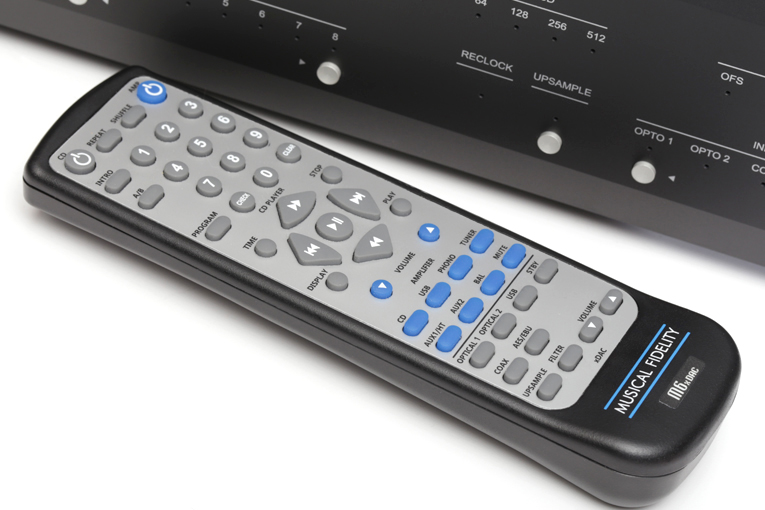
Musical Fidelity supplies a 48-button system remote with the M6x, which can be used to also control a CD player or an amplifier (or both) from the company’s M3, M5, or M6 ranges. Laid out neatly in three sections and color coded, the remote works well and would be convenient to owners of compatible components, but it doesn’t have the nicest feel. I preferred making my adjustments directly on the unit, especially for volume level.
Setup
The system I used to audition this top-of-the-line DAC consisted of reference-level components, all wired together by Nordost Valhalla 2 cables.
The two source components were an exaSound Delta streaming server ($2999) and an EMM Labs XDS1 CD/SACD player ($25,000), which I used only as a CD transport. I connected both digital sources to the M6x DAC and to my reference EMM Labs DV2 DAC ($30,000). The disc player fed the M6x DAC via the AES/EBU interface, the DV2 DAC via the proprietary EMM Link interface. I used a USB connection for the exaSound server.
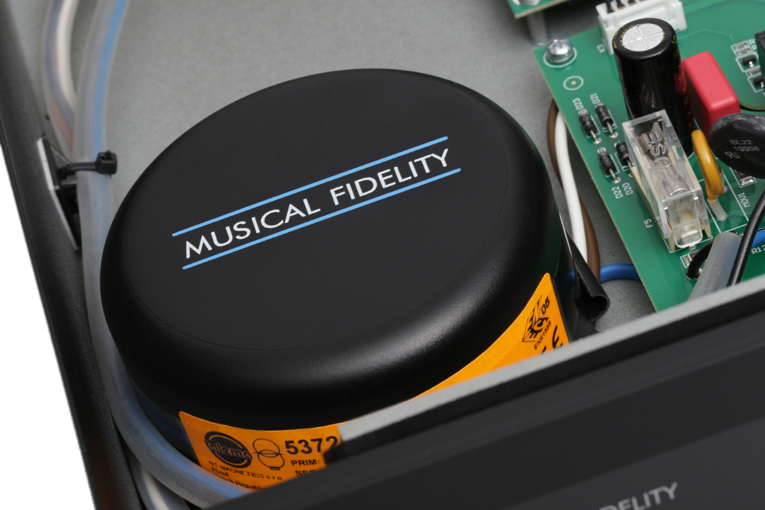
It may seem ridiculous to compare the M6x with the EMM Labs DV2, which costs 12 times as much. The object of this comparison was to see how the M6x stood up to one of the best DACs in the world—to test its absolute fidelity.
Output of the two DACs went to an EMM Labs Pre2 preamplifier ($15,000). I tested the M6x’s balanced and unbalanced outputs, using an SPL meter to ensure output level was the same in both modes, and heard no difference. I used the balanced connection for the rest of my listening.
The Pre2 preamp then fed a Soulution 511 stereo power amp ($32,000). The Soulution 511 is a high-resolution powerhouse, outputting 140Wpc into 8 ohms, 280Wpc into 4 ohms, or 560Wpc into 2 ohms, with distortion of 0.001% from 20Hz to 20kHz at 50Wpc and a damping factor of over 10,000. It’s right up there with the best solid-state amps made today. The Soulution 511 drove a pair of YG Hailey 2.2 speakers ($46,800 per pair), three-way sealed box units with a sensitivity of 87dB (2.83V/1m) and a nominal 4-ohm impedance, each speaker weighing 167 pounds.
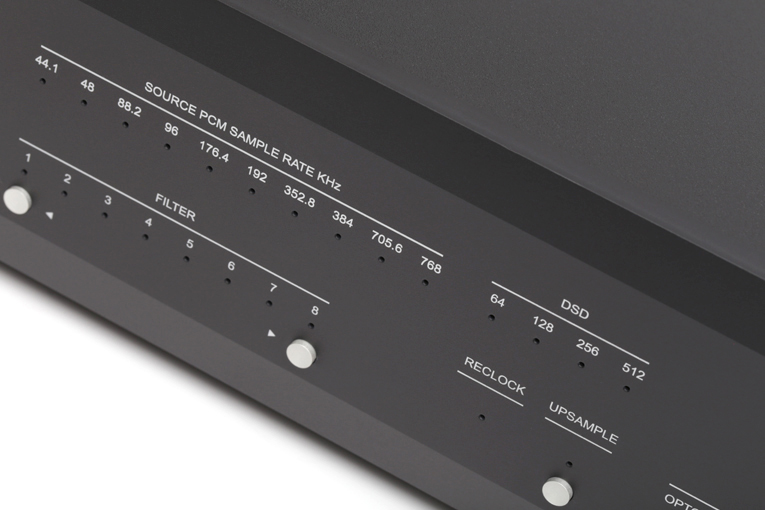
The M6x DAC offers seven filter options for PCM data as well as an oversampling bypass, but Musical Fidelity suggests you start with option 1 (linear phase, fast roll off), with upsampling enabled. Once accustomed to the sound of the DAC with this filter, you can experiment with the others to see if another filter sounds better to you. I found the differences marginal, but option 3 (minimum phase, fast roll off) was slightly better overall and was the one I selected for this audition.
Listening
I began my listening session with Antony Michaelson’s beautifully recorded performance of the Mozart and Brahms clarinet quintets, a rereleased 1999 CD (Musical Fidelity MF014). Much to my disbelief, I could barely tell the difference between the DV2 and M6x DACs. Both offered superb tonality and articulation, full bandwidth, and spectacular imaging. Most unusually, the M6x DAC exhibited no audible high-frequency roll-off, allowing that gorgeous clarinet sound to be reproduced brilliantly. There was no trace of harshness either. The DV2 had a slight edge on the M6x, however, in the greater specificity of its imaging.
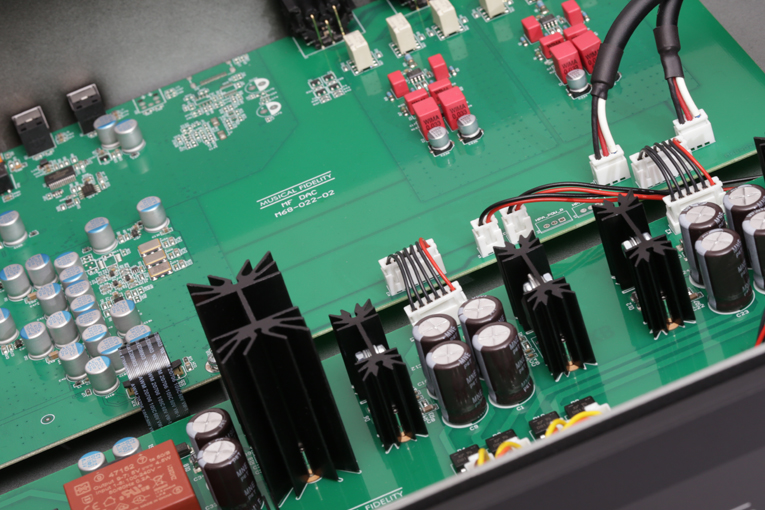
Staying with classical music, I moved to recordings with greater dynamic range and more bass content, a tougher test. Working my way upward in scale, I streamed an outstanding new recording of music for strings by Vaughan Williams, Howells, Delius, and Elgar, played by the Sinfonia of London under John Wilson (24-bit/96kHz FLAC, Chandos / Qobuz). This album concludes with a vigorous performance of Elgar’s Introduction and Allegro for Strings. It had a commanding presence through the M6x with rich, powerful sound, leaving no doubt that this is a superb DAC, closely approaching the reference EMM Labs DV2.
Even larger in scale, but at standard Red Book CD resolution, comes Portrait, a collection of live recordings by the Bavarian Radio Chorus and Symphony Orchestra under Bernard Haitink (BR Klassik 900174). This 11-CD box set lists now for around $58 on Amazon; I bought it in 2018 for $17. Haitink’s spirited interpretation of Mahler’s Symphony No. 9, the last CD in the set, was particularly impressive. The maestro was 87 at the time! This recording also demonstrates that the maligned Red Book standard, when properly executed and when played back on the right gear, is capable of magnificent sound. The M6x was evidently the right DAC. It readily conveyed the weight of a symphony orchestra in full flight, never allowing the more sonorous instruments to eclipse softer ones, never losing soundstage dimensionality. Once again, comparing the M6x DAC to my EMM Labs DV2, I had to strain to tell the one from the other.
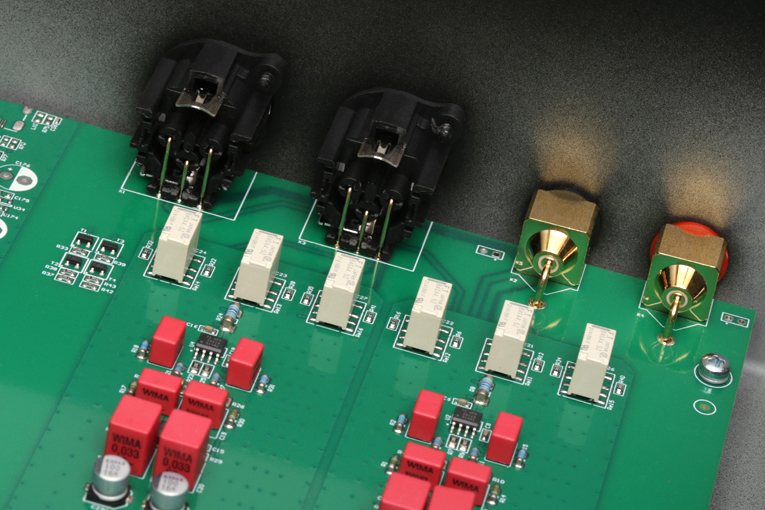
AfroCubism (Nonesuch 2-525993) is another beautifully recorded CD from World Circuit Records, the label that brought you the Buena Vista Social Club. Through the M6x DAC, this album sounded so delectable that I couldn’t just sample it, I had to play it right through to the closing number, “Guantanamera.” The M6x DAC delivered this album with relaxed in-the-room feel and seemingly limitless dynamic and frequency ranges. The low end dug deep with full control and power while sounding open and mellifluous on all instruments. The transient response and the sustain on plucked instruments were impressive. Imaging was excellent too, if a fraction less precise than with the DV2.
I continued with various other recordings in a range of resolutions. Te Amo, Argentina, by Antonio Lysy (Yarlung Records YAR95793DSD), is a DSD256 recording I have on my hard disk that has breathtaking sound quality. The M6x DAC did it full justice; I don’t think it gets any better than this. Even the reference DV2 DAC could not improve on the M6x’s palpable rendering of this fully dimensional recording.

Near the end of my audition, however, I played some CDs where the DV2 did pull away cleanly from the M6x DAC. This was most evident in “Summertime,” from The Best of Billy Stewart (Chess 088 112 369-2). The M6x DAC performed strongly on this high-energy track, and if I didn’t know better, I’d say it did a perfect job. But I do: the DV2 had greater intensity and more focused imaging. I detected similar but smaller advantages on a few other high-energy recordings, such as “Wristband,” on Paul Simon’s Stranger to Stranger (Concord 088072398030), and “Diamonds on the Soles of Her Shoes,” from Simon’s Graceland (Warner 25447).
Finally, Leonard Cohen’s last album, You Want It Darker (Columbia 88985365072), with its unfathomably deep vocals, showed again the slight edge the DV2 DAC holds over the M6x DAC: on track after track, Cohen’s voice was just that bit more realistic and precisely located with the DV2. “Leaving the Table” (whose opening bars evoke the soundtrack to Twin Peaks) and “Traveling Light,” in particular, brought out these small but significant differences in soundstage dimensionality and imaging precision between the DV2 and M6x. Still, both DACs delivered this album superbly, taking me right back to a live performance of Cohen I saw in Toronto in 2012, while he was on his farewell world tour.
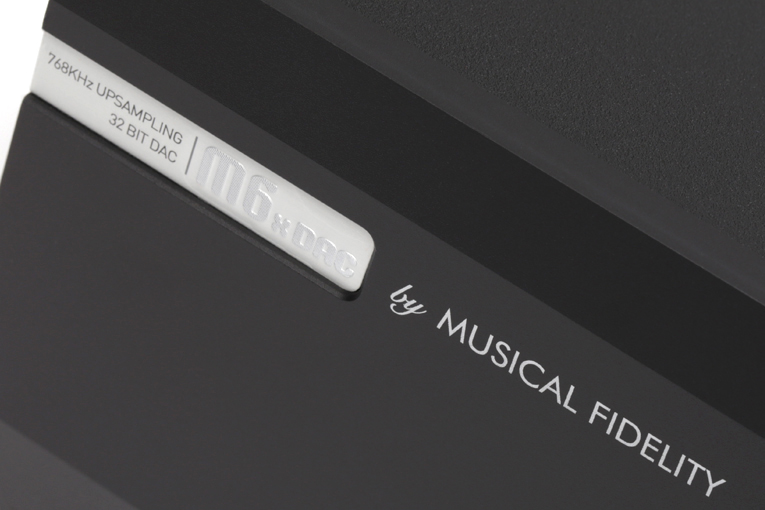
One last test remained to conclude my audition: playing nothing loudly. Pausing the CD player and turning the volume up to max, I then approached one of my speakers and listened closely. With my reference DAC, I heard but the faintest of hums from the midrange driver, my ear just inches away, and nothing but silence from the tweeter and bass driver. With the M6x DAC, I heard that hum again from the midrange driver—a fair bit louder this time, a hiss just audible from the tweeter, and nothing from the bass driver, as before. I couldn’t hear anything from a mere 3′ away, though, so this is of no concern at all; it is an excellent result.
Headphone listening
To assess the headphone output of the M6x DAC, I used my Sony MDR-Z1R open-back headphones ($1800). These top-of-the-line ’phones use 70mm (2.8″) magnesium-dome drivers with liquid-crystal polymer edges. With a rated sensitivity of 100dB/mW and 64-ohm impedance, the Z1R headphones are an easy load to drive.
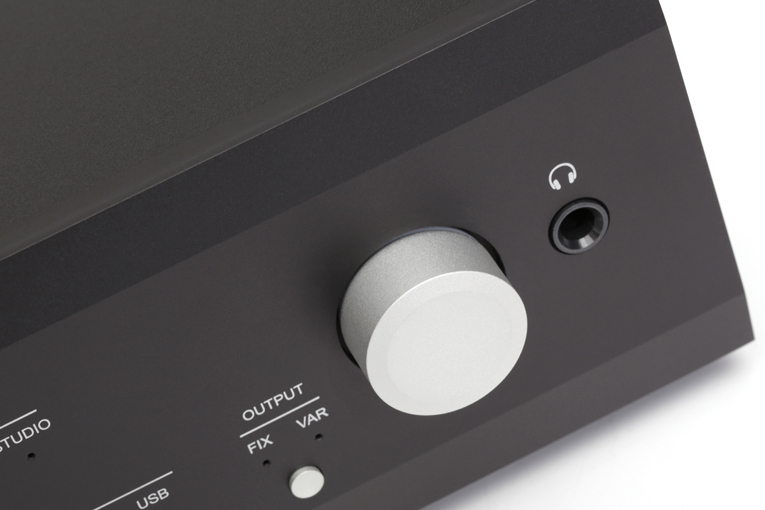
I listened to many of the same recordings I used before with my speakers. Switching alternately between the speakers and the headphones, I heard a very close match—a rare achievement, in my experience. I then compared the M6x DAC’s headphone output to my Graham Slee Solo Ultra Linear Diamond Edition headphone amp ($1195), which puts out 140mW per channel into 32 ohms or 30mW per channel into 600 ohms. I reviewed the Solo many years ago using several different headphones, including a pair of Sennheiser HD 800s, which it drove very well. With the Z1Rs, though, the Graham Slee was far less neutral, sounding bass-heavy and dark. It was as if it couldn’t quite control them. The Z1Rs sounded much cleaner, more natural, and more musical when driven by the Musical Fidelity.
Conclusion
The Musical Fidelity M6x DAC really surprised me. Very few DACs from just five years ago could hold a candle to it in sound quality. And although I have heard marginally better sound from much more expensive DACs, I have yet to hear a DAC at this price level with such natural and realistic sound across such a broad range of music. If you already have a good preamp or integrated amp and can bypass the M6x DAC’s volume control, I highly recommend it. From a price-performance perspective in this crowded, competitive field, the M6x DAC stands out.
. . . Phil Gold
philgold@soundstage.com
Note: for the full suite of measurements from the SoundStage! Audio-Electronics Lab, click here.
Associated Equipment
- Digital sources: EMM Labs XDS1 SACD player, exaSound Delta streaming server.
- Digital-to-analog converter: EMM Labs DV2.
- Preamplifier: EMM Labs Pre2.
- Power amplifier: Soulution 511.
- Loudspeakers: YG Hailey 2.2.
- Power, interconnect, and speaker cables: Nordost Valhalla 2.
- USB link: Nordost Tyr 2.
- Headphones: Sony MDR-Z1R.
- Headphone amplifier: Graham Slee Solo Ultra Linear Diamond Edition.
Musical Fidelity M6x Digital-to-Analog Converter
Price: $2500.
Warranty: Five years, parts and labor with registration.
Musical Fidelity
A division of Audio Tuning Vertriebs GmbH
Margaretenstrasse 98
A-1050 Vien
Austria
Phone: +43 50443
Website: www.musicalfidelity.com
Email: info@musicalfidelity.com






















